The carpet in any room has several functions: it is a link between the floor, walls and furniture, a wonderful decor, as well as a warm coating that is pleasant to walk on barefoot. Carpeting can set the mood for the kitchen, emphasize the chosen style of the room, and also visually expand the space.
What is the magic? Well-chosen material!
Carpeting is one way space zoning. When combination of kitchen and living room you can avoid the installation of false walls, shelving and other devices - the carpet will perfectly cope with this task. However, carpeting on the kitchen floor is not only for zoning. It gives coziness to the room, pleasant tactile sensations, etc. In our article, we will talk in detail about the advantages and disadvantages of carpeting in the kitchen, the types of carpets and much more.
Content
- Advantages and disadvantages of carpet on the kitchen floor
- Where to place the carpet in the kitchen?
- The size and shape of carpets for the kitchen
- Color and pattern of carpets for the kitchen
- Types of carpets for the kitchen floor
- Carpet care in the kitchen
- How to choose a carpet. Carpets are modern, classic, universal. Video
Advantages and disadvantages of carpet on the kitchen floor
The carpet in the kitchen is an extremely unacceptable thing for someone. And it is clear why: constant crumbs, spilled liquids, grease and other contaminants will always be present in this room. But there are carpets that are easy to clean, shake out and even wash in a typewriter. At the same time, “trampling” on it with bare feet while cooking is a pleasure.
Below we list the most significant pros and cons of carpets in the kitchen. Perhaps someone will change his mind that the kitchen is not a place for him.
"Per":
- Achieving coziness, comfort and warmth in the kitchen. You especially appreciate it in the cold season, when heating is not yet supplied to the apartments, and cold comes from the floor. Needless to say, standing on a soft warm surface is more pleasant than on a laminate or porcelain tile.
- Extending the life of your flooring, especially when it comes to, for example, a laminate, which in the working area (at the sink or stove) most quickly becomes unusable, swelling from water, losing its appearance from pollution. The carpet in this case can not only hide the defects that have already appeared, but also protect the coating from damage.
- Soft carpet, perhaps even with a large pile - find for a family with a small child. It is worth making a reservation here: such a flooring is hardly suitable for a small kitchen, but it’s quite enough for a spacious or combined with a living room. The fleecy island will become the main playing field of the baby, while the mother will take care of the housework, fussing a few steps away from him.
- Visual increase in kitchen areaif you choose the right size and color of the carpet. We will talk about this a little later.
- Carpet in the kitchen can be the main focus rooms, especially if it is made in bright colors against the background of plain walls, floors, furniture, kitchen sets.
- Space zoning. In a combined kitchen-living room, the carpet will perfectly serve as a material for separating the dining area from the cooking area, as in the photo below.
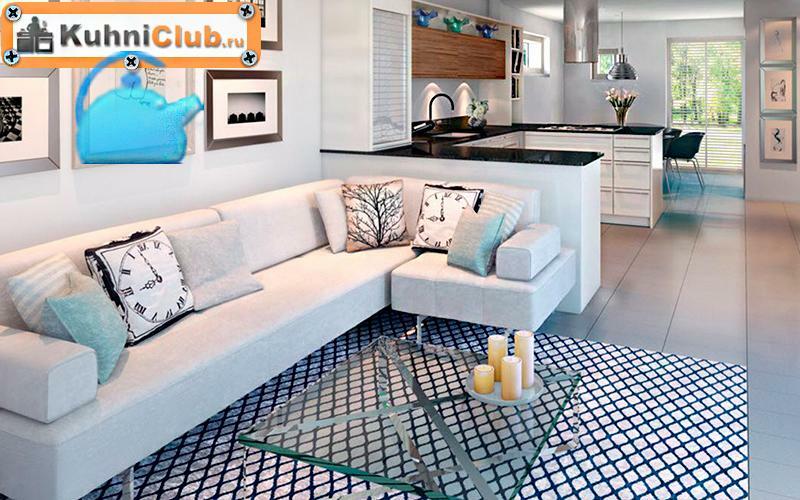
"Against":
- Carpets in the kitchen will have to be cleaned very often, vacuumed, washed, shaken out, because here we are dealing with an endless stream of food, liquid, greasy drops, etc.
- Due to constant laundry activities, the lifespan of carpeting in the kitchen will be shorter compared to that in the living room or bedroom.
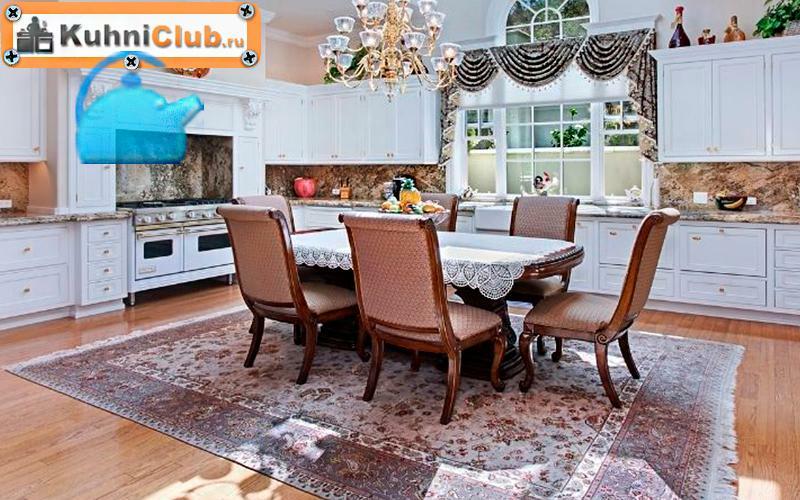
Where to place the carpet in the kitchen?
Where can the carpet be located in the kitchen? Everything will depend on its size, purpose and even color. The most common places for carpet flooring are:
- In the sink area. To do this, it will be enough to put a small square or rectangular carpet, since its task is to be an island for the hostess while she washes the dishes.
- Along the work area. Here it is better to lay a carpet, including the length of the entire kitchen set. Width and color of a covering are chosen at will.
- Under the dining table. In this case, the choice of carpet should be given maximum attention, since it will be larger, more visible, and in some cases will become the main focus of the kitchen as a whole.
And now let's talk about the sizes, shapes and colors of carpets in more detail.
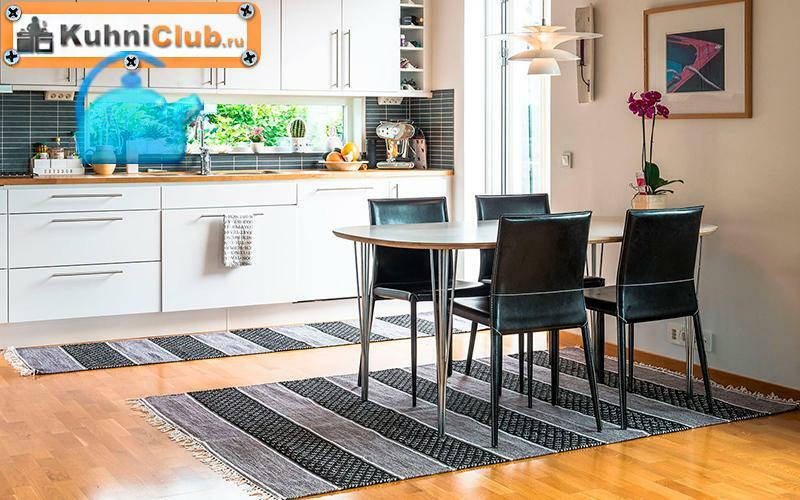
The size and shape of carpets for the kitchen
Size and shape naturally matter. And carpet is no exception. Let's start our conversation with the kitchen-living room or with a spacious kitchen, where the zero-two-four rule applies. We are talking about the number of legs of any furniture (table, chairs, sofa) standing on the carpet.
The small size of the carpet means lack of legs furniture located in the kitchen-living room. Designers do not like to use this option for various reasons, however, in some interiors, a carpet without furniture standing on it will be quite a good option - but there is something to think about and think about. Why is this option not always appropriate? Firstly, a small carpet can move in one direction or another, that is, “walk”, especially if there are small playful children in the house. Secondly, a small carpet makes the kitchen look smaller, while a large one makes it visually more spacious, because this is what designers and customers most often want to achieve.
The minimum size of the carpet on which to stand dinner table and chairs, should be of such dimensions that the extended chairs do not extend beyond the carpet.
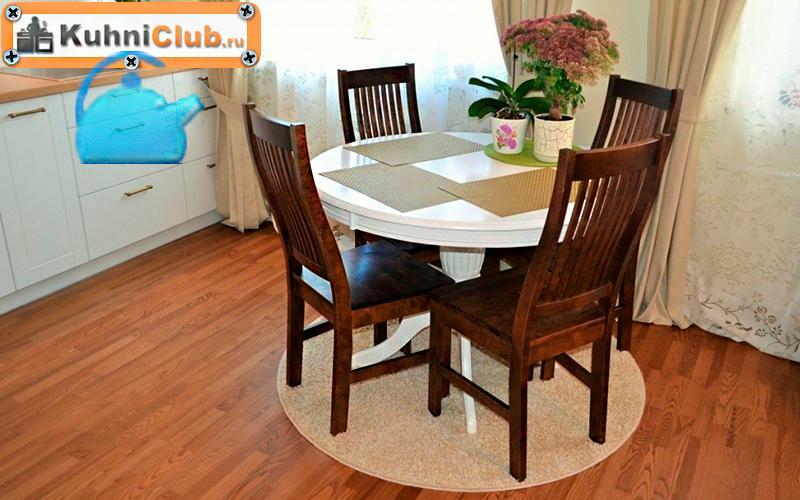
If sofas and armchairs are on the carpet two legs, it is well perceived visually. The room becomes more spacious and more complete. Option when all four legs stand on the carpet, suitable for very spacious kitchen-living rooms. In this case, the dining area will seem very large and harmonious.
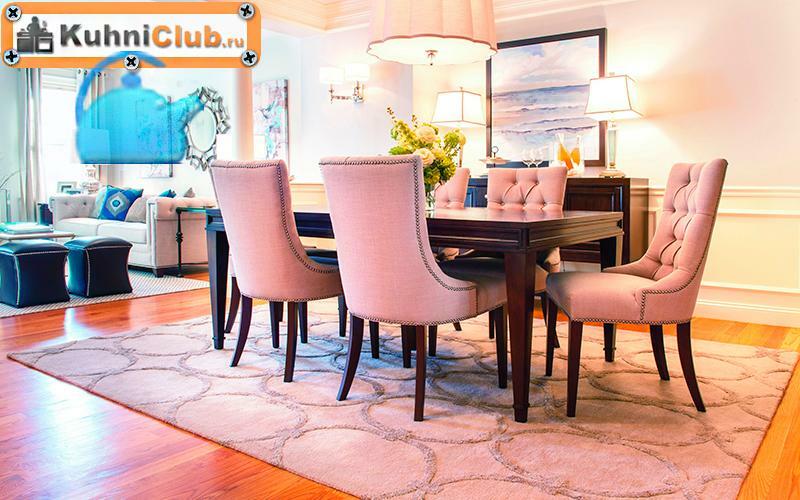
Most often, the shape of the furniture itself affects the shape of the carpet. One of the common options is a round carpet under round tabletop. However, this is not a rule that cannot be broken. If the sofa, table and other furniture are rectangular, the carpet can be round with the condition that there will be something similar in the interior of the kitchen. shape: a large round mirror on the wall, a decorative panel made of natural material, etc. Such a kitchen will be more complex, but very interesting in terms of design.
A round dining table goes well with a complex-shaped carpet, more reminiscent of a circle: teardrop-shaped, oval, etc. Bay window kitchen itself has a semicircular shape, so it is better to choose a round carpet flooring for the floor of this area.
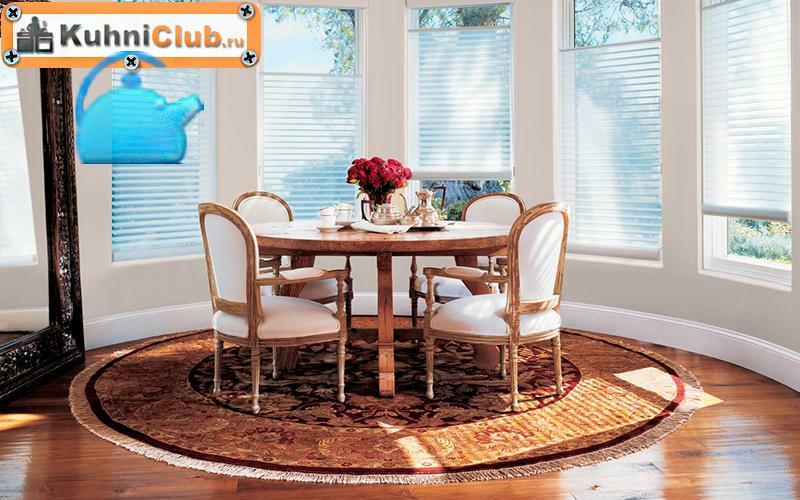
Another find of designers in achieving a complex but interesting interior is layering. Putting a small carpet on another, larger one is not considered bad manners. In this case, one of the carpets should be monophonic, the other - colored, while they should be combined with each other in shade or print. Most often, the base (monochrome) is the bottom carpet of a large size. If the soul requires color and colors, both carpets can be colored, with a pattern, but the main thing here is not to overdo it.
Layering is inherent in the kitchen boho style, where a variety of shapes, bright colors, creative solutions are collected in one space. After all, boho is an ethnic style of peoples, imbued with the spirit of freedom and their own centuries-old traditions. The laying of carpets here may not be perfectly symmetrical, but on the contrary - with an offset, on only one side of the carpet, which creates an image of some disorder and even chaos.
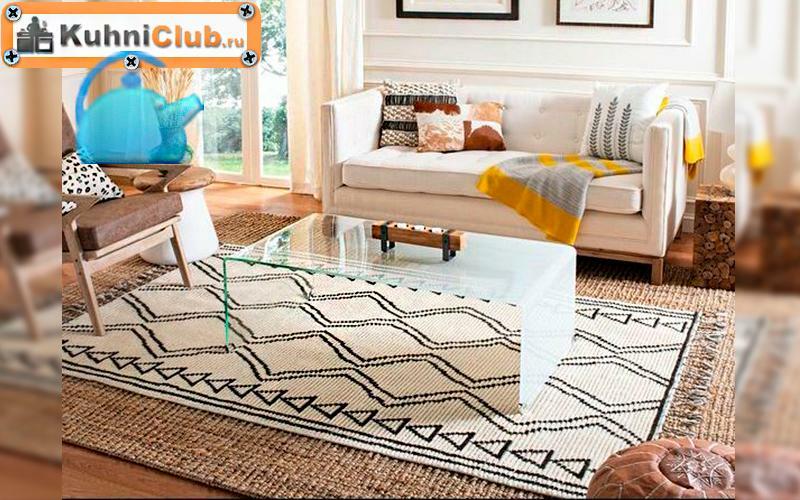
Another design decision that cannot be called popular is the presence of several carpets in the kitchen-living room. For example, a large carpet under the dining table, and a small one along the kitchen set, in the work area. Such “scattering” gives the room fragmentation, multi-zone, lack of a single space, which is not always necessary for the owner.
It is better to stick to the concept that the carpet serves to bring something together.
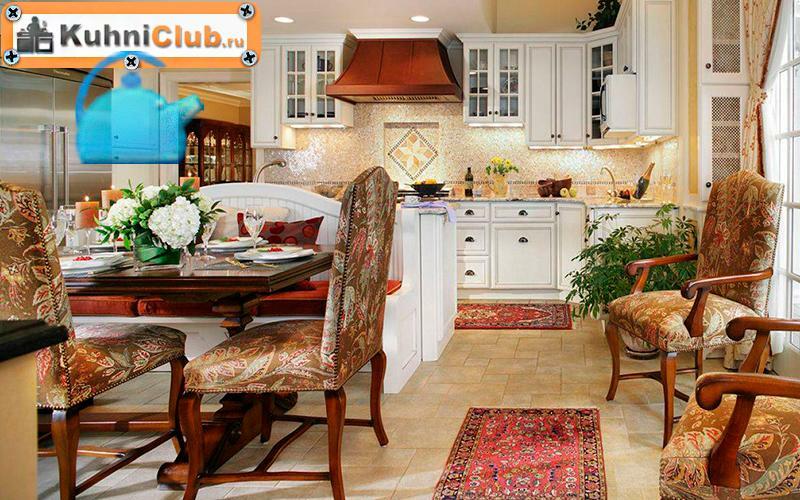
Color and pattern of carpets for the kitchen
It is better to move away from bright colors, catchy drawings. Plain carpets of the most calm shade will look more harmonious in a modern interior, as they will not take all the attention. However, there are exceptions - first things first.
The most common and simple version of the color of the carpet is the color of the walls or a couple of shades darker than it. Carpeting will not be conspicuous, but will give the kitchen-living room coziness and warmth. If the walls of the kitchen have dark tones, it is better to choose the carpet as light as possible. In this case, the room will not turn out to be gloomy, if it was not originally intended.
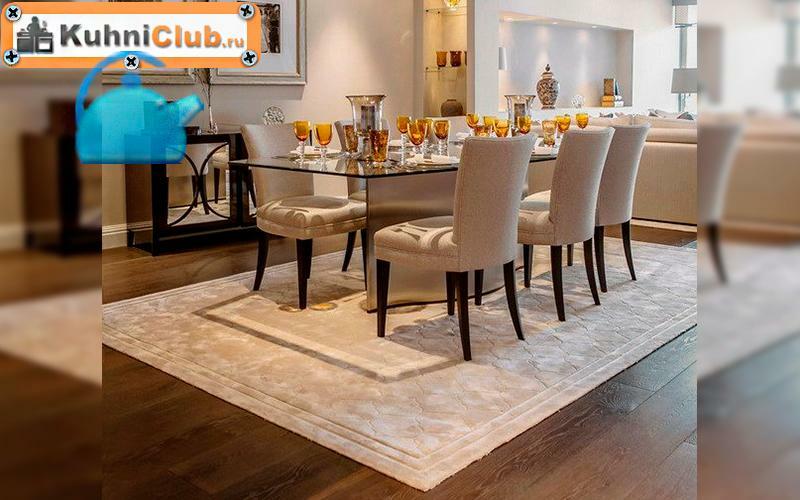
The same logic should be followed if kitchen wallpaper have a bright pattern, which is better to “shade off” with a plain, calm carpet. On the other hand, you can use carpeting with a catchy pattern, even if you have a colorful wallpaper. In this case, the carpet should be small, and the rest of the elements (furniture, floor, tablecloth on the dining table, curtains, etc.) should be solid in a calm color, for example, pastel shades.
The next option for choosing a carpet by color is the maximum match to the floor. In this case, carpet flooring will perform a functional role - protecting the flooring, for example, parquet. Almost any carpets, including textured ones, are suitable for the kitchen-living room. Tactile perception when walking barefoot on the carpet will be an incomparable sensation: wrapping in warmth, setting you up for relaxation and home comfort.
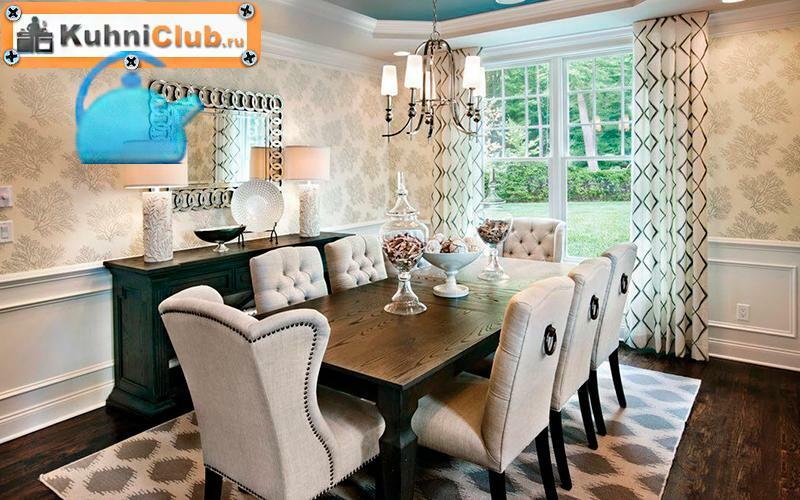
If a bright carpet with multiple shades was purchased in advance or it has always been in your home and passed from generation in a generation, and the kitchen is waiting for repairs, then it should be the starting point in creating primary colors premises. The colors of the carpet should, albeit unobtrusively, be repeated in the interior: through pillowcases, pillows on the sofa, dining table cloth, panels on the wall, curtains, vases, rugs on the sofa, etc. The main color of the kitchen (walls, floor, kitchen set) should be calm shades.
The decision will not be boring when the carpet will be the only color, bright spot in the kitchen-living room. At the same time, the rest of the surfaces, from the floor, walls to decor and curtains, will be of the same, neutral shade. Here, the carpet can have absolutely any color and combination of shades. In any case, it will become the main highlight of the room, taking all the attention.
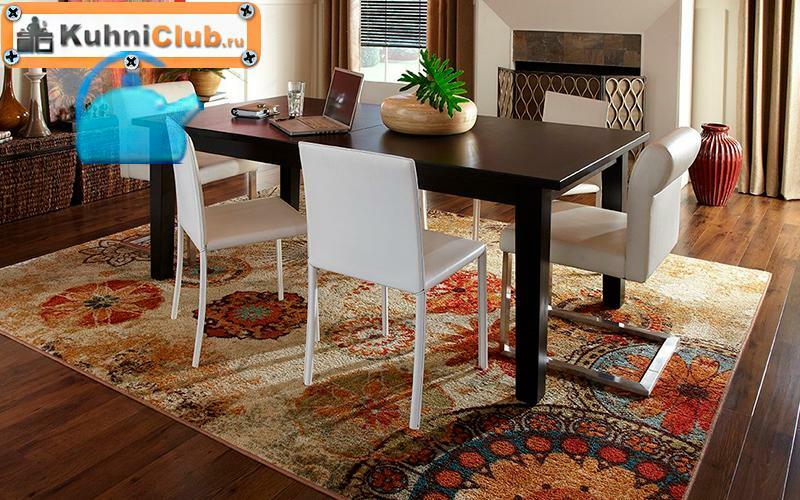
Types of carpets for the kitchen floor
Not every carpet is suitable for the kitchen - its choice must be approached carefully, based on the characteristics of the room. Since the kitchen is an easily soiled room, the carpet flooring must be resistant to both dirt and constant movement on it.
All types of carpets are divided into 2 main types: lint-free and piled (with a low pile of about 2-3 cm, high - up to 10 cm). Lint-free carpeting is the best solution for the kitchen.
The most common types of carpets: lint-free, easy to clean; homespun cotton, like a grandmother in the village, easily washed in a washing machine; eco-friendly wicker; carpets that do not slip on the floor, and even with pile (short, long). But the choice of carpets for the kitchen is actually much larger than we think. In our article, we list only the most popular of them:
-
Classic lint-free carpet not more than 8 mm thick. Lint-free carpets can be called something between ordinary carpets and mats, which we will discuss below. Most often they are woven from cotton or wool and have no pile, which is great for the kitchen floor. The peculiarity of such carpets is a soft material that provides comfort to the feet.
Lint-free carpet flooring suits most kitchen styles, from classical and modern to loft and Provence. The main advantage of such carpets: the material does not collect debris, is easy to care for, and is durable.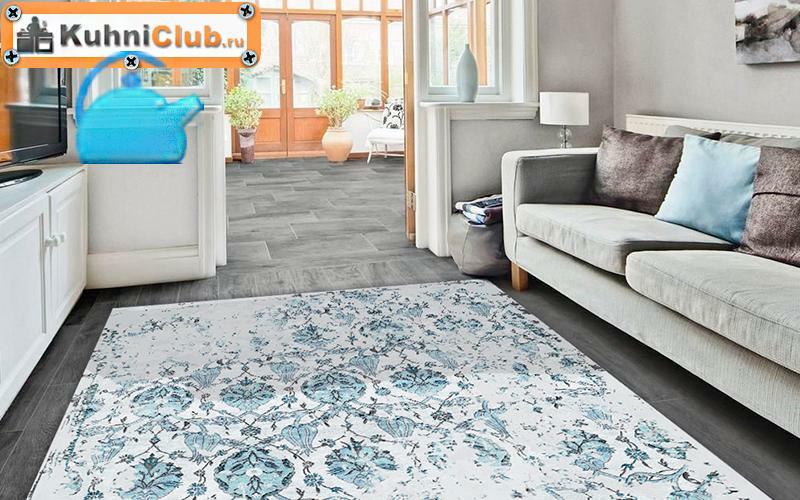
Lint-free carpet in the kitchen-living room -
Bamboo mat. Mat (woven carpet made of natural material, such as straw, reeds, reeds, bamboo, jute etc.) is the choice of those who prefer to use sustainable materials to equip their at home. After all, environmental friendliness and naturalness - trend of recent years.
At an inexpensive price, the mat has a number of advantages: style and practicality, as well as ease of cleaning, since a sponge is enough to clean its smooth surface. The mat does not collect dust, so the material is completely hypoallergenic and is very well suited for the kitchen floor - minimal maintenance is provided.
Despite the fact that the material used to create the mat is natural rods, the final product can have a pattern and even texture, which allows you to “fit” such a carpet into any interior.
The kitchen, on the floor of which the mat proudly lies, can be made in an oriental, modern style, style minimalism and even country music.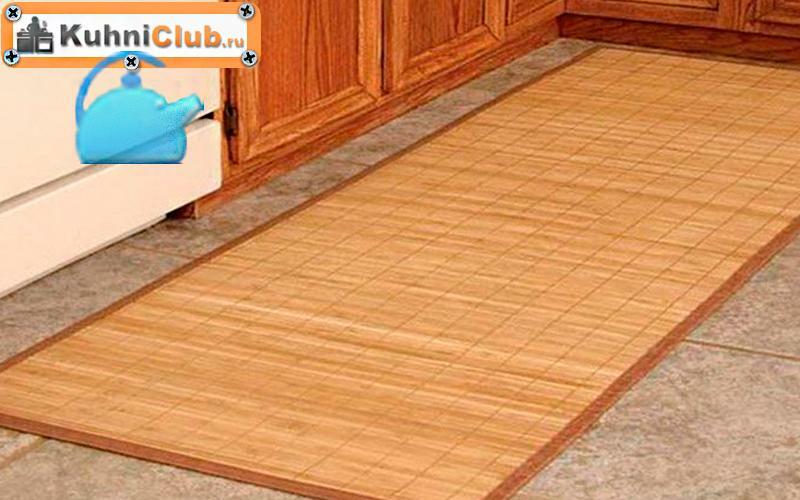
Bamboo mat on the kitchen floor -
Carpet homespun paths (rugs). This is a woven carpet, woven from multi-colored narrow scraps of fabric. Most of our readers, having read about “homespun paths” and looking at the photo below, immediately recall cozy, warm, hospitable house of a grandmother, who had handmade rugs on a clean wooden floor work. In those days, such paths were in every house. Years have passed, but the love for homespun rugs has not passed - on the contrary, many designers with fill the kitchen space with this “grandmother’s” material with pleasure, filling the room the atmosphere of antiquity.
Currently, not only the material for the manufacture of homespun rugs has changed, but also the size of the rugs, as well as its print. Modern walkways are made wider and not as long as before.
Homespun runners are great for country style kitchens and scandinavian stylegaining popularity around the world.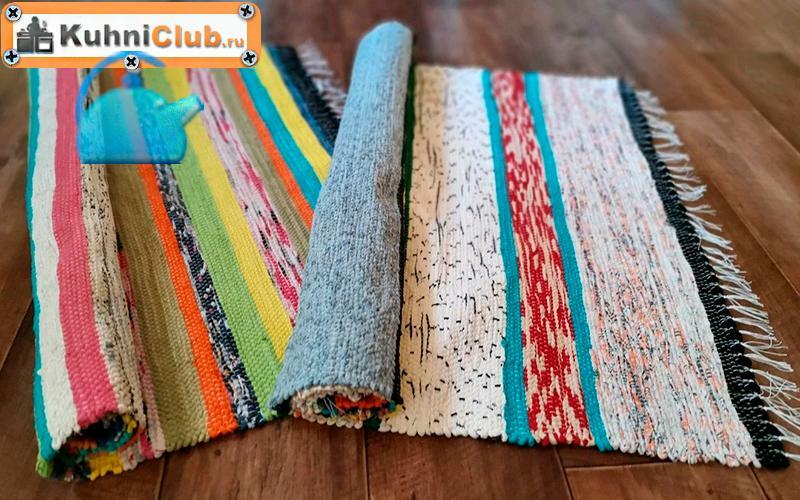
Handmade homespun walkways -
Palace. It is often confused with carpet, although they are different things. Palas is a lint-free double-sided coating consisting of loops, which makes it very strong and durable. The carpet does not have a long pile, such a carpet is always long, but not very wide.
The process of making rugs is machine or manual, which does not distinguish it from a carpet. Traditionally, rugs are made in the form of rectangles, including narrow, long ones. The carpet can be of any shape. It is believed that the width of the carpet does not exceed 100 cm, while its length is calculated in meters. Now the width can change upwards.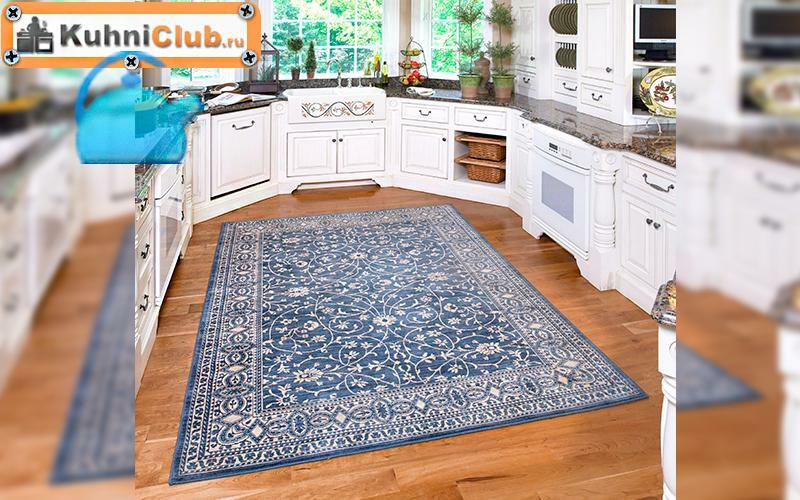
Palace on the kitchen floor -
Flannel carpets. This soft, literally plush material can also be used to make a rug for the kitchen. Flannel absorbs moisture well, is easy to clean, while the carpet does not slip on the floor surface.
Caring for such a rug will be washing it in a machine with a program at a low speed. Machine drying is not recommended by the manufacturer. The flannel cover can be washed by hand, but not in hot water.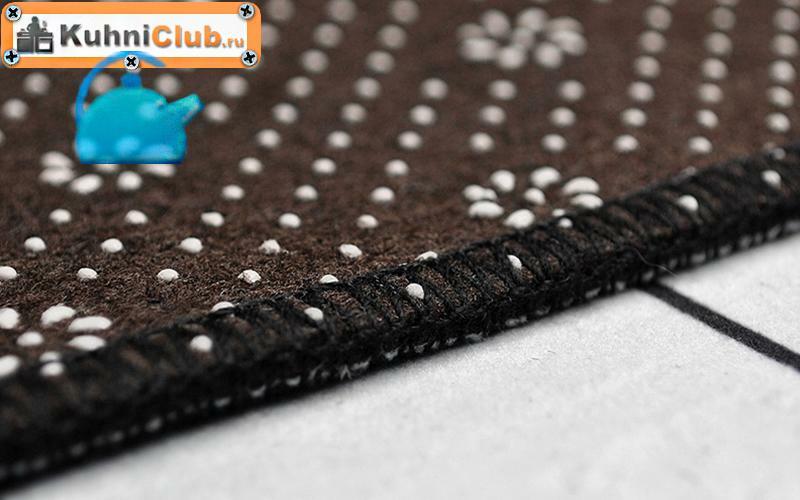
Flannel floor mat -
Kilim. This is a lint-free smooth double-sided carpet, which is based on the use of a woolen thread woven into a fabric base. Kilim is made by hand, so the cost of such a carpet will be high. A complex weaving technique requires several months of work from the master, resulting in a very durable and unique carpet that will emphasize the luxury of any interior. A more inexpensive analogue is polyurethane kilim.
Also among the advantages of kilim: ease of cleaning and long service life. In a real, genuine kilim, the pattern will be on both sides.
Kilim is suitable for both oriental and modern cuisine, Scandinavian style, country style, boho style, etc.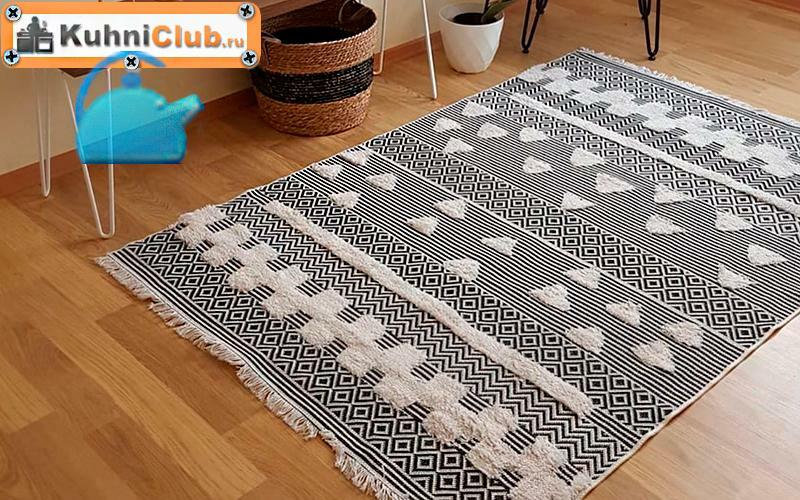
Kilim carpet handmade -
Shaggy carpet (or Shaggy, which means “shaggy, fleecy” in English). From the translation of the word, it is clear that we are talking about carpets with a very long pile - up to 8 cm. The longer the pile, the more pleasant it is to the touch and the more difficult the carpet is to clean.
Such floorings are made of hypoallergenic material that does not cause any allergic reactions, which allows you to lay it on the kitchen floor so that a small child can sit on it.
Shaggy carpets can be either plain or have a certain ornament. Tactile sensations when touched depend on the length of the pile, and the longer the pile, the more difficult it is to care for the coating. Also among the shortcomings: the pile is easily trampled and does not look as presentable as when buying; small crumbs are very difficult to pull out of the carpet; Dust easily clogs into the pile, which is difficult to get out of it, so the preferred option is to periodically take it to a dry cleaner for professional cleaning.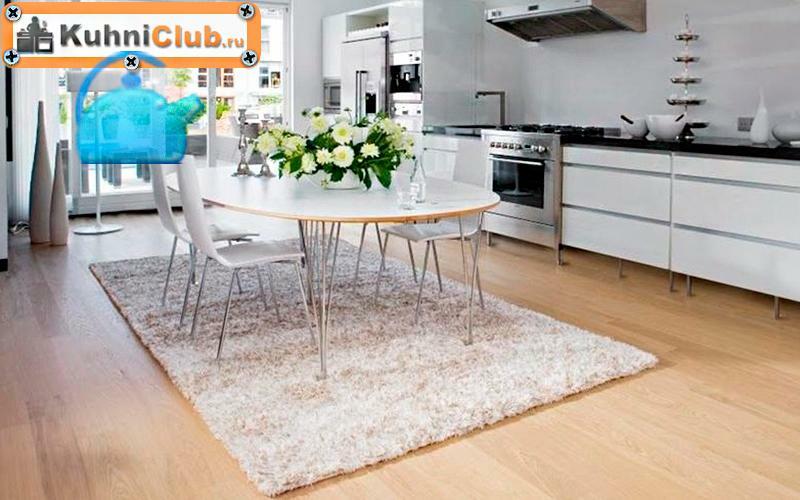
Shaggy carpet on the floor of the kitchen-living room -
Vinyl carpet. Such carpeting is based on elastovinyl - an environmentally friendly analogue of rubber. Among the advantages of vinyl carpet flooring: safety of use, including in the kitchen; does not stain the floor surface during the entire period of use; does not emit hazardous substances; keeps color for a long time; does not lose properties even with constant exposure to direct sunlight; resistant to high humidity; has a huge variety in color, pattern; has a long service life and low cost.
Vinyl-backed rugs can imitate classic prints as well as luxurious patterns, oriental weave patterns, and more.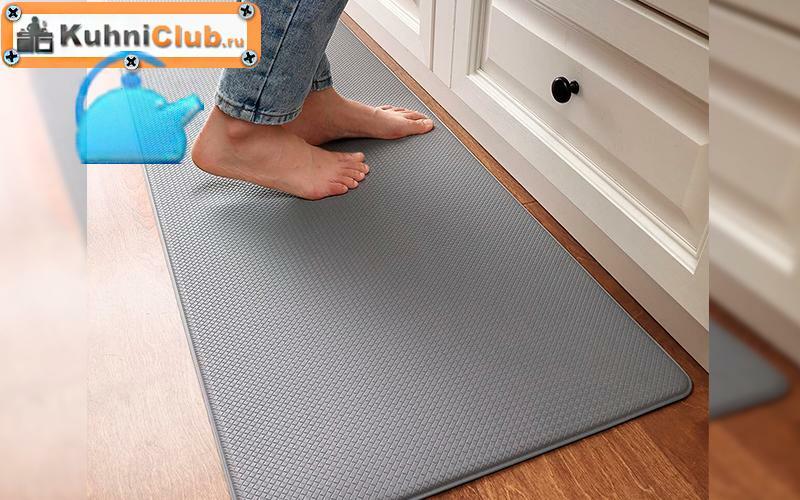
Vinyl lint-free carpet
Carpet care in the kitchen
Every thing needs care. We have already looked at carpet materials that are easy to clean and which will bring some difficulties. In any case, in order for the carpet in the kitchen to last for a long time, it is better to follow the basic rules that we have collected based on people's feedback and the opinion of professionals:
- It is best to remove the stain as soon as it appears. For this, special shampoos, washing vacuum cleaners, etc. are used. If the stain cannot be removed, it is preferable to take the carpet to a dry cleaner or invite professional cleaning to your home.
- It is not recommended to clean carpets with hot water. Comfortable water temperature for cleaning - no more than 50 ° C. Under the action of high temperatures, not only the design of the carpet can deteriorate, but also the material itself, for example, adhesive bonding, which is often used to create carpets.
- It is not recommended to use hard brushes when cleaning the carpet, so as not to spoil its surface.
- If the carpet is made of natural material, the use of chemicals is prohibited.


